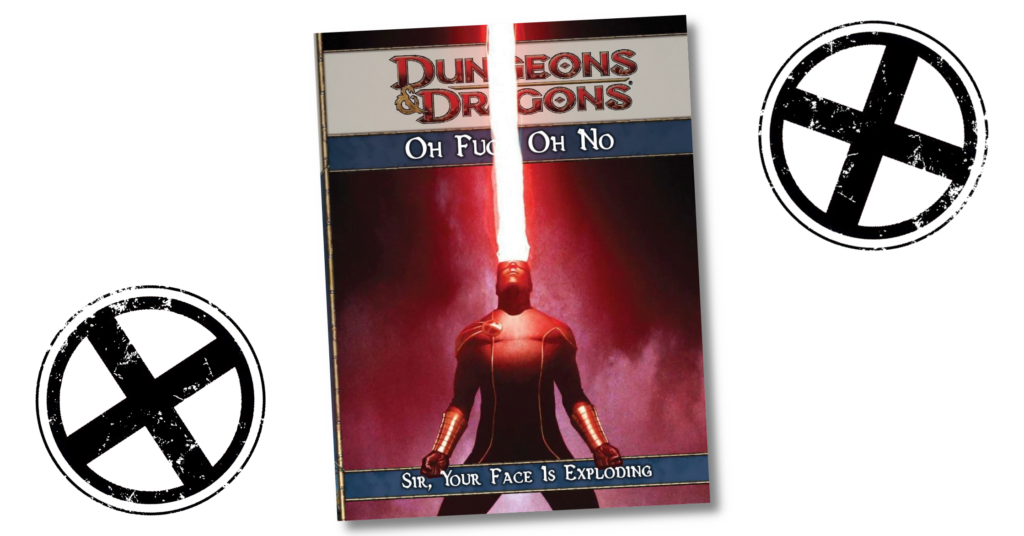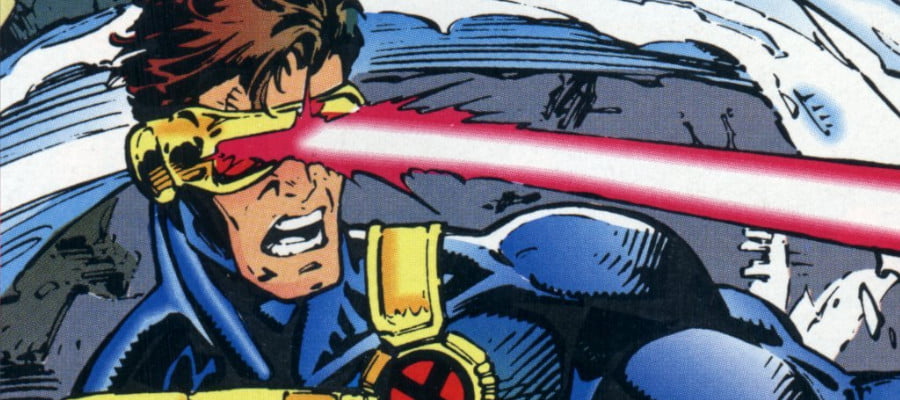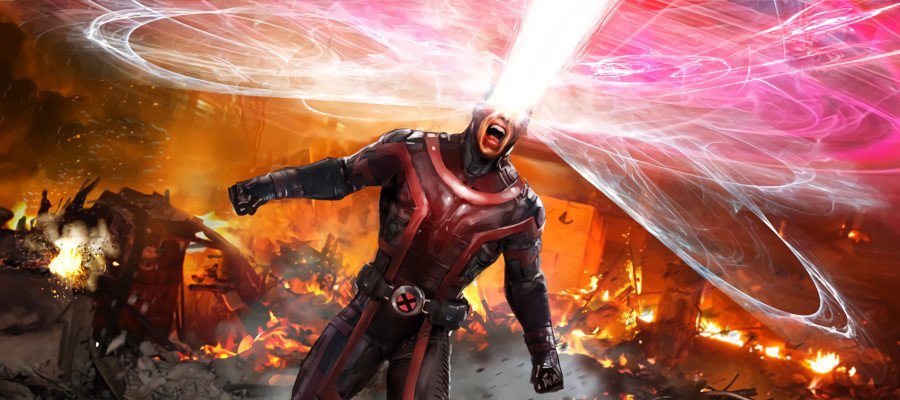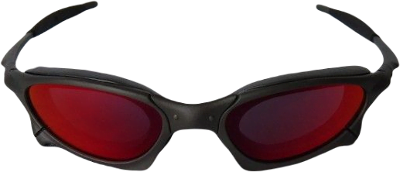In How To Be we’re going to look at a variety of characters from Not D&D and conceptualise how you might go about making a version of that character in the form of D&D that matters on this blog, D&D 4th Edition. Our guidelines are as follows:
- This is going to be a brief rundown of ways to make a character that ‘feels’ like the source character
- This isn’t meant to be comprehensive or authoritative but as a creative exercise
- While not every character can work immediately out of the box, the aim is to make sure they have a character ‘feel’ as soon as possible
- The character has to have the ‘feeling’ of the character by at least midway through Heroic
When building characters in 4th Edition it’s worth remembering that there are a lot of different ways to do the same basic thing. This isn’t going to be comprehensive, or even particularly fleshed out, and instead give you some places to start when you want to make something.
Another thing to remember is that 4e characters tend to be more about collected interactions of groups of things – it’s not that you get a build with specific rules about what you have to take, and when, and why, like you’re lockpicking your way through a design in the hopes of getting an overlap eventually. Character building is about packages, not programs, and we’ll talk about some packages and reference them going forwards.
I’m always left wondering, month to month if I can come up with an interesting example for How To Be, where I wonder when I’m going to feel like I’m running out of options. For GDQ I was considering a list of ‘speedrunning iconic characters considered, then rejected the entire list because I realised that, once again, I could imagine a way to represent that character, a way to capture the essence. Plus, there’s always different veins of narrative, different types of stories to consider like this.
A long time ago, when I first started playing RPGs, a friend (hi BigAngry) said to me, the thing with RPGs is that once you play in them you’ll notice the way that literally every single piece of fan media presents you a list of toys, things you can always look at, then point to and say ‘I want that.’
And I thought about another friend who doesn’t care about RPGs, and I thought: Yeah. Let’s do Cyclops.

Who Is Cyclops
Cyclops is a mutant from the X-Men universe, something that technically, Disney owns but has spent the past twenty years letting other people use to the extent that it was easier to buy the company than resolve the contract disputes. There’s a lot of words you can drop about the character, about the different ways you can consider this character the more and deeper into the text you pore, which is really interesting because if you just look at the surface representation of the character in all the most common ways to engage with him, he’s a grown up class dobber.
Cyclops has a single power that defines almost everything about how he interacts with the world around him; his eyes, when left to their own devices, generate a powerful laser blast that’s capable of destroying almost everything that he points it at. It’s a classic power-disempowerment fantasy; the ability to destroy anything you look at, and then the challenge of how you grapple with that being always on. The character has some cool ideas you can use him to explore – I’ve seen him explored as an example of Masking, the autistic perspective of needing to maintain a perfect representation of a self so as to not ever make anyone confront the reality of what you are, knowing that it would be permanently mistrusted.
I’ve also seen him considered as an example of the way that white privilege crushes even the people who benefit from it; Cyclops is a dude who is handsome and powerful and in a position of power, but the problems of living up to the standards expected of a Guy Like Him is the kind of thing that crushes the spirit over time and results in this guy unable to reconcile the person he has to be and the person he knows he can live up to being even while being fully aware that he’s more than that.
I’m talking about personality and potential here, though, because trust me, outside of that optic blast, I could tell you he did anything and you’d probably go ‘oh, that makes sense.’ This is the problem of comic book characters with seventy years of history to walk through. If I said that Cyclops had a racism-powered type of martial art training, you’d want to check what I meant rather than reject it outright. If I told you he was a skilled second-storey thief, same deal. About the only thing that stands out that is required for him to work is the optic blast, and how that works to express your character.

Singular Focus
But that’s a good thing too. It means we really get to look at this and think about what doesn’t work with it. There’s a lot of different things you can do with a character, but doing Cyclops just asks a question:
Can you build this character who primarily interacts with people by blasting them with lasers?
Okay, but if we’re blasting with a laser, what can’t we do? The most obvious thing is that you don’t have a weapon – Cyclops doesn’t run around punching people (well, sometimes) or wielding a weapon (well, sometimes), but the core of that optic blast needs to work, and it needs to be the primary thing you do to attack people.
If you don’t have a weapon, that means you almost certainly have an implement instead. If you’re an implement based character, you probably fight at range, probably, which works for Cyclops. You might think ‘hang on, if I fight at range that means this character has to be ranged, and that probably means they’re just a ranged attacker,’ but don’t worry!
Oh, and Cyclops’ clothing is something something unstable molecules something something so that great big body paint onesie is in fact already a type of heavy, full-body armour that’s padded to the extent you need it to. You could call that heavy armour or light armour and the only disagreement is going to be how you see the character moving.
What that means is our baseline for Cyclops:
- A non-weapon user who
- Can attack at range with a laser blast and
- Wears whatever level of armour you want
From there, the question, in my mind is… what role do you want to fulfill?

Leader: The Cleric
The shift of the cleric from the 3.5 spellcaster who swung a weapon most of the time to the 4e one was such an interesting shift to see happen in real time. Clerics always had some cool spells that had remote, divine power feelings, like flame strike but you never really felt like you were primarily a blaster type; clerics had to be in melee to heal people. The 4e cleric had a whole different build accessible from level 1 that ran alongside the melee option, and players were suddenly free to mix and match based on what they liked.
The result is that there is a leader archetype whose #1 way of interacting with the world is ranged radiant attacks, blasts of light that can kill (ie, lasers). You grab this class out of the player’s handbook, and look for implement powers, which kind of builds itself. There’s almost always a choice between two powers and that choice can be influenced by things like the types of damage you want to do.
As with many such classes, you can build this towards the Radiant Mafia stuff, with the Morninglord class.
Defender: The Paladin
Alongside the Cleric, we have the Paladin, who have a weirder relationship with the implement blasts. Because the Paladin is a defender; its job is to stand in the middle of a group of enemies, get punched and kicked, and punish them for the temerity of trying to stop them. The Paladin’s at-will powers all require a melee weapon, and they’re there to give you tools for punishing or enabling most of the time. That’s not totally a dealbreaker — you could point to Marvel Vs Capcom, for example, for an example of a Cyclops who can punch and kick.
In that case, you could grab the Monk multiclass, which lets you treat your implement as a melee weapon (by empowering your unarmed attacks), and then you can jam radiant damage onto them with the Sun Disk of Pelor. Because uh, well, all your attacks probably want to be radiant, because that makes you more like blasting out lasers, and then again, you can tie it into the Morninglord.
Controller: The Psion
Oh thank goodness, something that isn’t just another divine blaster that chains into the Morninglord oh wait hang on
Controller: The Invoker
Yeah okay, here we are again, the Invoker as another way to make a ranged blasting radiant damage type because lasers are really easily tied to radiant damage, okay. The Invoker is a beast of a class, but part of what makes it so good is the incredibly reliable encounter powers. The Invoker is an interesting class compared to the other more on-the-nose example of Cyclops powers, because it’s not got the same ability to command as a ‘leader’ (do these things and I will support you) or the personal authority of a defender (I will take the hits to protect you), but instead you get a different, less approached form of the kind of character Cyclops is.
Specifically, the Invoker version of Cyclops is one whose message is ‘I will make an opportunity by hyperfocusing a hole through people.’
Invokers? Light armour. Holy symbols as implements again. You get to lay out all sorts of radiant vulnerability (and if you go Morninglord, you can do that, even more). You know, I could go back and edit in the Morninglord as an option for the ‘everything’ category, but you know what, let’s just leave it as a surprise.

Junk Drawer
If you’re willing to expand your vision of a ‘laser’ you can definitely use the psion to represent Cyclops, but you have to pick your powers carefully. You could even use the telepathy communication powers in terms of ‘I have a powerful psychic hiding somewhere else who backs me up’ which may be your kind of cool. You could also take the Warlock, which even gets to add summons and tactical positioning, but when your primary way of dealing with anyone is blasting things with a laser, all the weirdo complicated things a Warlock can do with the curses and special debuff powers probably is meant to represent single, individual tactical moments where Cyclops notices something, cares about it, and deduces a plan for what to do with it.
The thing that stands out to me about all of these choices as I tried to build Cyclops was how much the importance of mental stats came up. Cyclops isn’t a character where I think it’s important to know he can climb a rope or lift a crate or do a dance. The guy is a character overwhelmingly defined by intense mental states and they are also all linked to practices that it’s easy to make invisible.
Whatever your Cyclops is, or how they’re doing it, think about what it’s like to be under that stress of having a dangerous weapon behind your eyes all the time. Maybe that’s what the Divine origin is for all of these variants I suggest; some powers are divine origin because they’re done by spiritual entities or an ideal in which the user is invested. Some powers are divine origin because the person who uses them is so autistic that the need to project a normal mental state creates world-shattering laser blasts bursting out of the eyes. The choice is yours.
